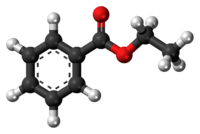Ethyl benzoate
 | |
 | |
| Names | |
|---|---|
| IUPAC name
Ethyl benzoate | |
| Identifiers | |
| 93-89-0 | |
| 3D model (Jmol) | Interactive image |
| ChEMBL | ChEMBL510714 |
| ChemSpider | 6897 |
| ECHA InfoCard | 100.002.078 |
| UNII | J115BRJ15H |
| |
| |
| Properties | |
| C9H10O2 | |
| Molar mass | 150.18 g·mol−1 |
| Density | 1.050 g/cm3 |
| Melting point | −34 °C (−29 °F; 239 K) |
| Boiling point | 211 to 213 °C (412 to 415 °F; 484 to 486 K) |
| Related compounds | |
| Related compounds |
Methyl benzoate Propyl benzoate |
| Except where otherwise noted, data are given for materials in their standard state (at 25 °C [77 °F], 100 kPa). | |
| | |
| Infobox references | |
Ethyl benzoate, C9H10O2, is the ester formed by the condensation of benzoic acid and ethanol. It is a colorless liquid that is almost insoluble in water, but miscible with most organic solvents.
As with many volatile esters, ethyl benzoate has a pleasant odor described as sweet, wintergreen, fruity, medicinal, cherry, and grape.[1] It is a component of some fragrances and artificial fruit flavors.
Preparation
A simple and commonly used method for the preparation of ethyl benzoate in laboratory is the acidic esterification of benzoic acid with ethanol and sulfuric acid as catalyst:[2]
References
- ↑ Ethyl benzoate, thegoodscentscompany.com
- ↑ Arthur Israel Vogel. Rev. by Brian S. Furniss: Vogel’s textbook of practical organic chemistry. 5. Auflage. Longman, Harlow 1989, ISBN 0-582-46236-3, S. 1076
External links
This article is issued from Wikipedia - version of the 6/23/2015. The text is available under the Creative Commons Attribution/Share Alike but additional terms may apply for the media files.
